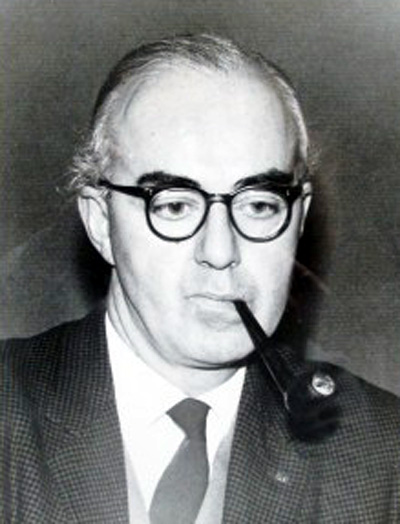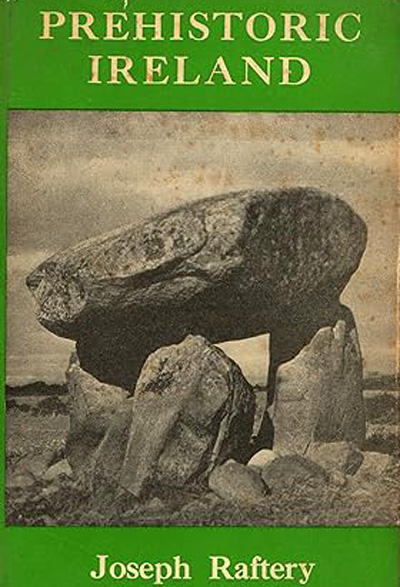Joseph Raftery (1913–1992)
 Joseph Raftery (1913–1992)
is recognized as a prominent figure in Irish archaeology, whose multifaceted career spanned several decades. Born in Dublin to John Raftery,
governor of Mountjoy prison, Raftery's formative years were predominantly spent in Portlaoise, County Laois.
Joseph Raftery (1913–1992)
is recognized as a prominent figure in Irish archaeology, whose multifaceted career spanned several decades. Born in Dublin to John Raftery,
governor of Mountjoy prison, Raftery's formative years were predominantly spent in Portlaoise, County Laois.
His academic journey commenced with a scholarship to St. Mary's CBS, where his scholarly aptitude earned him a subsequent scholarship to University College Dublin where he pursued a degree in Celtic studies in 1933, followed by a master's degree in archaeology in 1934. His master's thesis, titled 'Archaeological monuments in Counties Laois and Tipperary', demonstrated an early interest in regional archaeology.
Raftery's scholarly pursuits were further facilitated by a bursary in archaeology, affording him the opportunity to conduct research across Europe and collaborate with esteemed archaeologists. Notably, he worked alongside Hugh O'Neill Hencken of the Harvard Archaeological Mission to Ireland, refining his fieldwork skills. His academic journey culminated in a von Humboldt fellowship, leading to a doctorate from the University of Marburg in 1939.
In the same year, Raftery's personal and professional life intersected as he married Charlotte Lang, whom he had met during his studies in Germany. Their return to Ireland coincided with the outbreak of World War II, marking the commencement of Raftery's tenure at the National Museum of Ireland. Initially appointed in 1939, he rose through the ranks, assuming the role of acting keeper of Irish antiquities in 1945, before being formally confirmed in this position in 1949. Subsequently, in 1976, he ascended to the directorship of the National Museum of Ireland, a position he held until his retirement in 1979.
Throughout his tenure at the National Museum of Ireland, Raftery's contributions as curator of the national archaeological collections were substantial. His acquisitions, ranging from the Gorteenreagh gold hoard from County Clare to various artifacts unearthed during agricultural endeavors, significantly enriched the museum's holdings. Moreover, his excavations at sites such as Cairn H in Loughcrew, County Meath, and Lough Gara, County Sligo, not only expanded the National Museum of Ireland's collections but also provided invaluable insights into Ireland's prehistoric past.
 Raftery's scholarly impact extended beyond his museum duties, evident in his prolific publication record. Notable among his publications is
Prehistoric Ireland, which despite its delayed release in 1951, remains a seminal work in the field. Additionally, his engagement with
contentious archaeological debates, exemplified by his article 'Ex Oriente...', published in the Journal of the Royal Society of Antiquaries
of Ireland in 1965, underscores his intellectual rigor and willingness to challenge prevailing interpretations.
Raftery's scholarly impact extended beyond his museum duties, evident in his prolific publication record. Notable among his publications is
Prehistoric Ireland, which despite its delayed release in 1951, remains a seminal work in the field. Additionally, his engagement with
contentious archaeological debates, exemplified by his article 'Ex Oriente...', published in the Journal of the Royal Society of Antiquaries
of Ireland in 1965, underscores his intellectual rigor and willingness to challenge prevailing interpretations.
However, Raftery's professional journey was not without challenges. Persistent underfunding of the National Museum of Ireland hindered the timely completion of major excavations and publications, reflecting broader systemic issues within the archaeological community. Despite these challenges, Raftery's commitment to advancing Irish archaeology remained unwavering, as evidenced by his active involvement in advisory bodies and advocacy for modernization initiatives.
Beyond his professional achievements, Raftery's personal demeanor, characterized by his affable nature and generosity, left a lasting impression on his colleagues and acquaintances. While he was known for his demanding leadership style, his acts of kindness and mentorship endeared him to many within the archaeological community.
Joseph Raftery's legacy endures as a testament to his scholarly contributions and unwavering dedication to Irish archaeology. His influence transcends disciplinary boundaries, leaving an indelible mark on the study and preservation of Ireland's rich cultural heritage.
Boyne Valley Private Day Tour
 Immerse yourself in the rich heritage and culture of the Boyne Valley with our full-day private tours.
Visit Newgrange World Heritage site, explore the Hill of Slane, where Saint Patrick famously lit the Paschal fire.
Discover the Hill of Tara, the ancient seat of power for the High Kings of Ireland.
Book Now
Immerse yourself in the rich heritage and culture of the Boyne Valley with our full-day private tours.
Visit Newgrange World Heritage site, explore the Hill of Slane, where Saint Patrick famously lit the Paschal fire.
Discover the Hill of Tara, the ancient seat of power for the High Kings of Ireland.
Book Now
Home
| Visitor Centre
| Tours
| Winter Solstice
| Solstice Lottery
| Images
| Local Area
| News
| Knowth
| Dowth
| Articles
| Art
| Books
| Directions
| Accommodation
| Contact
